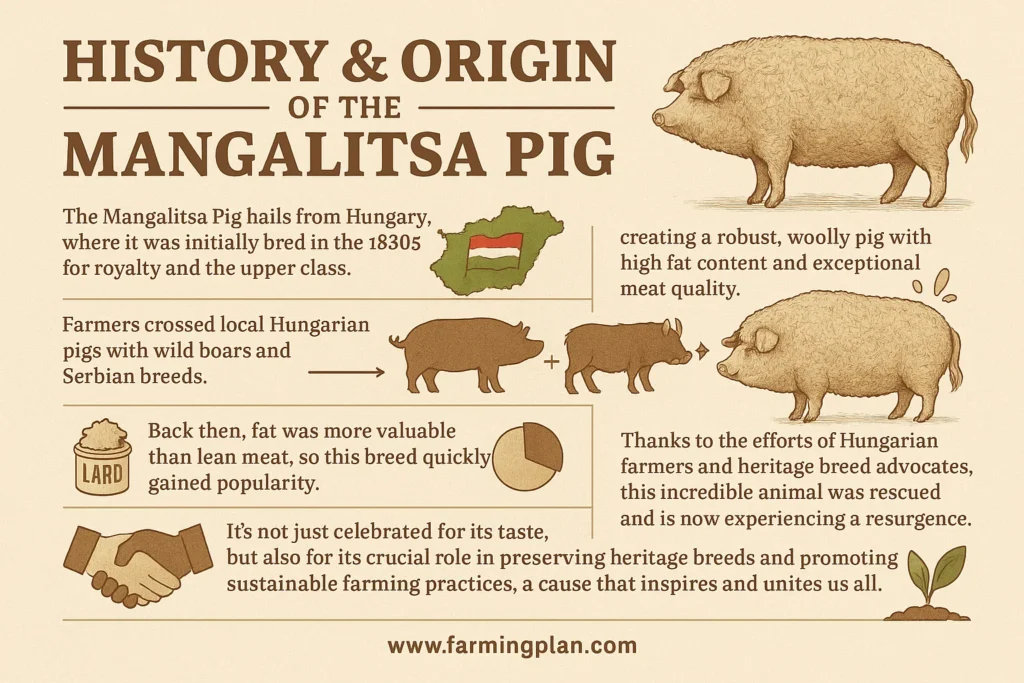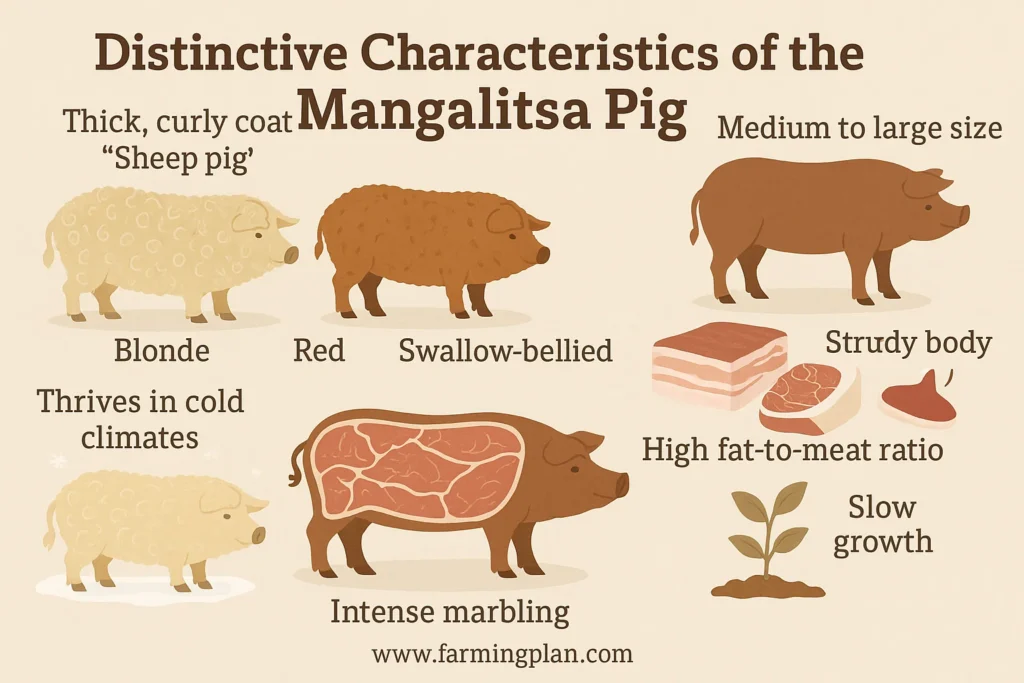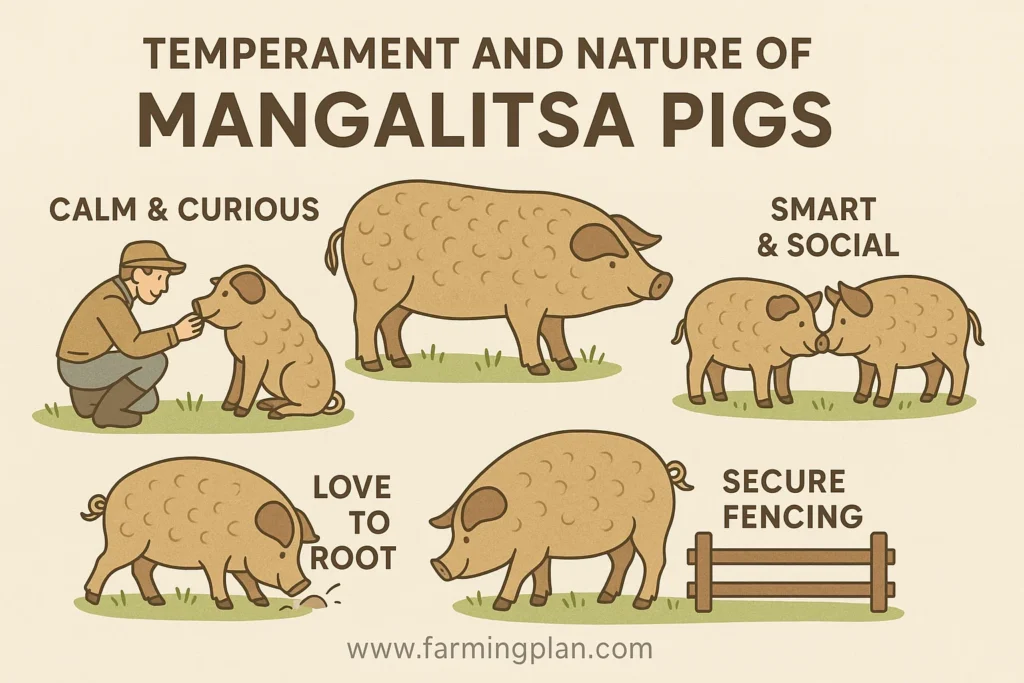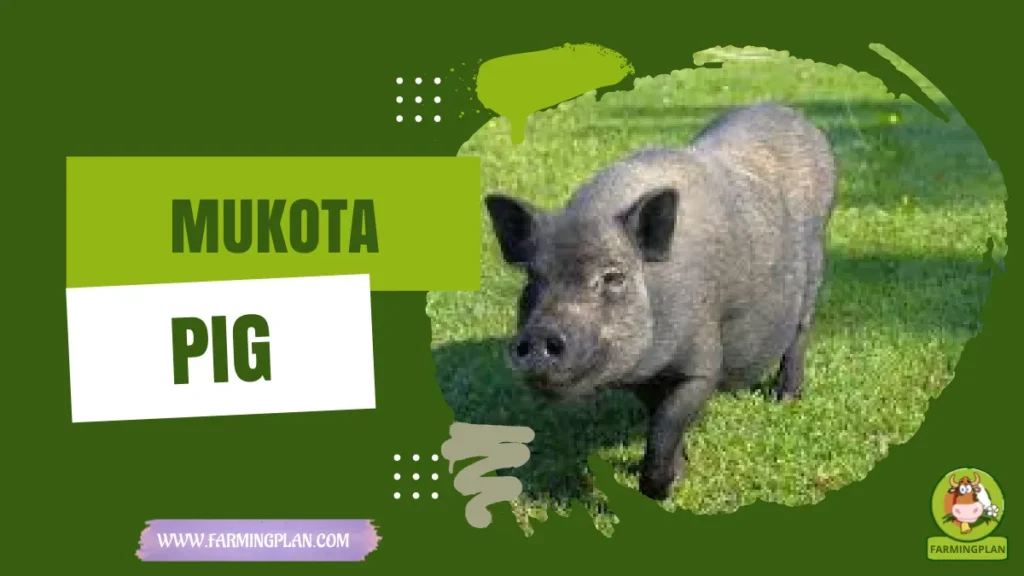If you’ve never heard of the Mangalitsa Pig, prepare to be captivated. This heritage breed, renowned for its thick, curly coat and rich marbled meat, is often referred to as the “Kobe beef of pork.” Food enthusiasts, chefs, and small farmers are drawn to its deep, nutty flavor, buttery texture, and creamy lard that seals in moisture during cooking. Unlike conventional pork, Mangalitsa pork—including cuts like Mangalitsa bacon and Mangalitsa pork chops—offers a taste experience that’s bold, tender, and unforgettable. Whether you’re considering raising a few hogs or simply craving the most delectable pork, the Mangalitsa promises an unparalleled quality and flavor that will leave you spellbound.

History & Origin of the Mangalitsa Pig
The Mangalitsa Pig hails from Hungary, where it was initially bred in the 1830s for royalty and the upper class. Farmers crossed local Hungarian pigs with wild boars and Serbian breeds, creating a robust, woolly pig with high fat content and exceptional meat quality. Back then, fat was more valuable than lean meat, so this breed quickly gained popularity. However, as modern farming favored leaner pig breeds, the Mangalitsa nearly vanished.

By the 1990s, fewer than 200 purebred Mangalitsas remained. Thanks to the efforts of Hungarian farmers and heritage breed advocates, this incredible animal was rescued and is now experiencing a resurgence. It’s not just celebrated for its taste, but also for its crucial role in preserving heritage breeds and promoting sustainable farming practices, a cause that inspires and unites us all.
Read More: American Yorkshire Pig Quick Facts
Distinctive Characteristics of the Mangalitsa Pig
The Mangalitsa Pig stands out immediately thanks to its thick, curly coat—earning it the nickname “sheep pig.” It comes in three main color types: Blonde, Red, and Swallow-bellied. These pigs are medium to large in size, with sturdy bodies and strong legs, perfect for foraging and outdoor life. Unlike many modern pig breeds, Mangalitsas grow slowly, which gives their meat time to develop its rich marbling and deep flavor.

Their thick coat helps them thrive in cold climates, making them ideal for small farms with changing weather. They also have a high fat-to-meat ratio, producing soft, creamy lard and high-quality meat that stays moist and flavorful when cooked. Every part of the Mangalitsa—from its woolly look to its intense marbling—makes it a rare and valuable breed in the pork world.
Read More: Duroc Pig: A Rare Breed of Domestic Pigs
Temperament and Nature of Mangalitsa Pigs
Mangalitsa pigs are calm, curious, and easy to work with, which makes them a great choice for small farms and even family-run homesteads. They enjoy human interaction and often respond well to gentle handling, especially when raised from piglets. These pigs are smart and social, forming strong bonds with each other and their caretakers.

Their friendly nature means they don’t need aggressive fencing like some other pig breeds, but they do love to dig and root around, so secure ground barriers are helpful. Because of their gentle temperament, Mangalitsas are a good match for farmers raising heritage breeds or anyone looking for pigs that are easy to manage and care for.
Read More: Red Wattle Hogs: Powerful Pigs, Tasty Pork
Food & Diet
The Mangalitsa Pig thrives on a natural, forage-based diet that brings out its rich flavor and marbled texture. These pigs do best when they can roam freely, eating grasses, roots, vegetables, and fallen fruit. Many farmers also feed them acorns, which give the meat a deep, nutty flavor prized by chefs and food lovers. Their natural diet helps produce creamy, healthy lard and meat full of intense flavor.
While they can eat grain and corn as supplements, avoid feeding processed foods or anything high in sugar or salt. Clean water and access to fresh forage are a must every day. Their diet not only affects the pig’s health but also the quality of the Mangalitsa meat, making feeding one of the most important parts of raising this heritage breed.
Purpose and Uses of the Mangalitsa Pig
The Mangalitsa Pig is raised mainly for its premium-quality meat, often called the “beef of pork” because of its rich marbling and deep flavor. It produces some of the world’s best pork products, including Mangalitsa bacon, pork chops, coppa, lonza, and dry-cured pancetta. This fatty, flavorful pork doesn’t need heavy seasoning and is ideal for slow cooking or pan-searing. Chefs love it for its juicy texture and ability to hold up under high heat. Some farmers also raise Mangalitsas as show pigs or even as pets, thanks to their gentle temperament and striking, woolly appearance.
However, it’s important to note that raising Mangalitsas can be more costly and labor-intensive than raising conventional pig breeds due to their slower growth rate and specific dietary needs. The initial cost of purchasing Mangalitsa piglets, the need for a larger space for them to roam and forage, and the time and effort required to provide them with a suitable diet are all factors to consider. Whether you’re a food enthusiast or a small-scale farmer, this pig delivers incredible value in the kitchen and on the farm.
Special Features That Make Mangalitsa Pigs Unique
The Mangalitsa Pig is no ordinary pig—it’s a rare heritage breed packed with unique traits. Its most striking feature is the thick, curly wool that protects it in cold climates, making it one of the only pigs with a sheep-like coat. But what truly sets it apart is its meat. Unlike lean commercial pork, Mangalitsa offers high-quality meat with rich marbling, a buttery texture, and a complex flavor that chefs and food lovers crave.
The creamy lard it produces is perfect for baking and high-heat cooking, and it’s considered a heart-healthy lard thanks to its natural fat profile. This pig also grows slower, which means more intense flavor and better texture in every bite. As a limited breed, Mangalitsa is treasured for its rarity, flavor, and connection to sustainable farming practices, a combination that will surely pique your interest.
Feed your Mangalitsa a diet rich in acorns and root veggies to boost marbling and lock in a bold, nutty flavor.
Health Issues and How to Prevent Them in Mangalitsa Pigs
The Mangalitsa Pig is generally a hardy breed, but like all pigs, it can be prone to certain health issues. One of the most common problems is parasites, such as worms and lice, which can affect the pig’s overall health and growth. To prevent this, regular deworming treatments and maintaining clean living conditions are essential. Another concern is hoof health—Mangalitsas tend to develop hoof problems if they don’t have enough space to roam and root around.
Make sure they have access to clean, dry bedding and plenty of room to move. Additionally, these pigs are slower to mature than commercial breeds, so keeping an eye on their weight and providing a balanced diet is crucial to prevent obesity. Routine veterinary care is important, and farmers should schedule regular health checks to ensure their pigs stay in top condition. With proper care and attention to their diet, Mangalitsa pigs can live a long, healthy life and produce some of the finest pork available.
Step-by-Step Farming Guide to Raising Mangalitsa Pigs
Raising Mangalitsa pigs is a rewarding experience that requires attention to detail and a commitment to their well-being. Here’s a simple, step-by-step guide to help you get started:
Step 1: Choose the Right Piglets
Choose Mangalitsa piglets that demonstrate excellent health alongside steady movement while getting your livestock from trusted breeders. Heritage breed Mangalitsa piglets can be purchased for sale from local farms and breeders who focus on preserving this rare breed.
Step 2: Build a Secure Shelter
Create a shelter environment which both protects your pigs from environmental conditions and ensures their space stays free of moisture. While Mangalitsa pigs demonstrate good resistance to harsh conditions they require shelter against severe weather elements. Your Mangalitsa pigs can find comfort and warmth in an open structure with proper ventilation and comfortable bedding.
Step 3: Establish a Foraging Area
The Mangalitsa breed reaches peak health through consumption of natural foods. Design a specific section of land for your Mangalitsas to eat grasses and roots and vegetables. To achieve optimal meat quality it is ideal for Mangalitsa pigs to roam in fields containing abundant acorns combined with other foraging food sources.
Step 4: Provide a Balanced Diet
In addition to foraging, you may want to supplement their diet with high-quality grains or protein to ensure they receive all necessary nutrients. Avoid feeding them processed foods or anything that could negatively impact their health or meat quality.
Step 5: Monitor Health Regularly
Regularly check your pigs for signs of illness, parasites, or hoof issues. Mangalitsa pigs require routine health checks and parasite control to stay healthy. Work with a vet who is familiar with heritage breeds to ensure they receive the best care.
Step 6: Provide Ample Space to Roam
Mangalitsa pigs need extensive space to carry out natural rooting behaviors and explore their territory. When possible circumstances allow it, let the pigs free-roam on pasture to achieve their best physical health as well as growth outcome. The pigs’ optimal meat quality forms alongside their enhanced flavor and texture as a result of free-range roaming.
Step 7: Be Patient with Growth
Mangalitsa pigs grow slowly, taking 2-3 years to reach full maturity. Be patient and allow them to grow at their natural pace. Their slower growth results in better flavor and texture in the meat.
Step 8: Harvesting and Butchering
When your Mangalitsa pigs mature properly it becomes essential to start considering the harvesting process. Your decision about when to slaughter Mangalitsa pigs depends on whether you plan to sell the pork or eat it yourself. Request an experienced butcher who will preserve the meat quality after your harvest.
Expert Tips & Best Practices for Raising Mangalitsa Pigs
Raising Mangalitsa pigs can be incredibly rewarding, but there are a few best practices to ensure you’re getting the most out of your heritage breed. Here are some expert tips to help you succeed:
Prioritize Quality Diet
The quality of your pigs’ meat depends fundamentally on what they eat in their diets. Your pigs need access to forage combined with high-quality protein-rich grains and vegetables to reach their growth and fat targets optimally. Acorns added to natural forages enhance your meat’s melt-in-your-mouth texture while improving flavor characteristics.
Practice Sustainable Farming
Since Mangalitsa pigs thrive on a natural diet and open space, practice sustainable farming methods by rotating grazing areas to prevent soil depletion and overgrazing. This also supports the healthier meat production for a longer lifespan of your pigs.
Provide Ample Space
Mangalitsas are active and love to root. Ensure your pigs have room to roam and explore to maintain both their physical and mental well-being. Adequate space prevents boredom and ensures the meat has the right texture and flavor.
Protect Their Skin
Alpacas need regular cleaning in warm areas because their wool helps protect them from the cold weather. Provide your dogs with a mud area where they can roll to maintain body temperature when hot weather occurs. This will help reduce their risk of heat stress.
Monitor Health Closely
Regular veterinary care is essential. Keep an eye out for common health issues, such as parasites, hoof problems, or respiratory issues. Make sure to give them routine parasite control, vaccinations, and hoof trimming to avoid health setbacks.
Be Patient with Growth
Mangalitsa pigs are slower to mature, so be prepared for a longer wait compared to commercial breeds. The payoff, however, is the high-quality pork that develops from their slow and steady growth. Don’t rush the process, and let the pigs mature naturally.
Ensure High-Quality Slaughter and Butchering
When it’s time to harvest, work with a butcher familiar with heritage breeds. This ensures that the unique flavor and marbling of Mangalitsa meat are preserved properly. Proper butchering will ensure that you get the most out of each cut, from Mangalitsa bacon to pork chops.
Where to Buy Mangalitsa Pigs
Finding healthy, high-quality Mangalitsa pigs for sale can be a bit of a challenge due to their rarity, but there are several options for purchasing these heritage pigs from reputable sources:
Local Farms and Heritage Breeders
The most reliable source to obtain Mangalitsa piglets for sale exists among regional breeders who focus on sustainable heritage breed livestock. Research farms which practice sustainable farming while emphasizing caring for their animals. Local breeders provide Mangalitsa hogs for purchase at multiple developmental stages including young piglets and older animals.
Online Marketplaces
Websites like Craigslist, Livestock of America, or specialty agricultural marketplaces sometimes list Mangalitsa pigs for sale. However, make sure to verify the source before purchasing to ensure you’re buying from a reputable seller who practices ethical breeding.
Heritage Breeders Associations
National and regional organizations dedicated to preserving heritage breeds often have breeder directories and resources for finding Mangalitsa pigs. For example, organizations like the American Livestock Breeds Conservancy or similar local groups often have listings for pigs available for sale.
Specialty Farms and Cooperatives
Some farms or cooperatives of farmers may focus exclusively on Mangalitsa pigs and their products. These farms may also offer Mangalitsa pork and related items like Mangalitsa bacon or Mangalitsa meat boxes directly to consumers.
Direct from Hungary
If you’re looking for authentic Mangalitsa hogs or want to breed them, you can sometimes find direct imports from Hungarian farms where the breed originated. Working with a reputable importer will ensure the pigs meet all health and regulatory standards.
Auctions
Heritage breed livestock auctions sometimes present Mangalitsa pigs as available for purchase to interested buyers. At these events you have the chance to place bids on pigs which farmers breed to protect rare premium-quality breeds. Review the auction’s reputation and evaluate the veterinary health of the animals before placing your bid.
FAQ
What is a Mangalitsa Pig?
The Mangalitsa pig is a rare heritage breed from Hungary and Austria, known for its curly, woolly coat and high-fat content. Often referred to as the “Kobe beef of pork,” it produces meat prized for its rich marbling and intense flavor.
How should I care for Mangalitsa pigs?
Mangalitsas are hardy and low-maintenance, requiring a clean, dry shelter and access to pasture for foraging. They thrive on a natural diet of grasses, roots, and occasional grains, and benefit from regular health checks and parasite control.
What makes Mangalitsa pork so special?
Mangalitsa pork is renowned for its high fat content, particularly omega-3 fatty acids, and its marbled texture. This results in tender, flavorful meat that is ideal for slow cooking and high-heat methods.
Are Mangalitsa pigs good for beginners?
Mangalitsa pigs exhibit peaceful temperaments alongside adaptable behavior which welcomes both veteran and novice farmers to raise them. The easy-going qualities combined with minimal care needs transform Mangalitsa pigs into pleasantly manageable animals for handlers.
Where can I buy Mangalitsa pigs?
Mangalitsa pigs can be purchased from reputable breeders, specialty farms, and heritage breed associations. It’s important to source from ethical breeders who prioritize animal welfare and maintain healthy breeding practices.
Conclusion
The Mangalitsa pig stands as a valuable breed due to its amazing meat quality which provides both great marbling and distinctive delicious taste. The breed’s adaptability and peaceful disposition makes it a suitable addition to different agricultural environments. Mangalitsas need both natural diet options and sufficient living space for successful development into premium pork producers. Raising Mangalitsa pigs presents both farmers with experience and beginners with a profitable chance to practice sustainable agriculture while creating culinary masterpieces.


